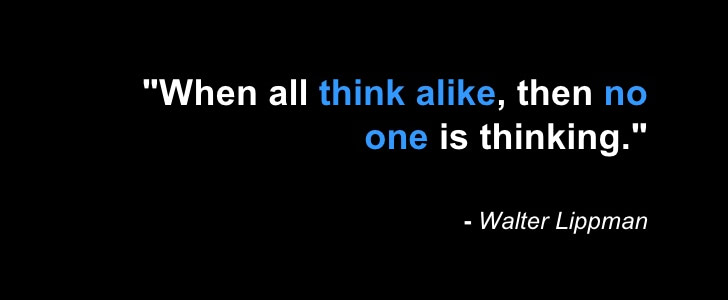Why? What? Who? How? Four key questions College leaders must ask when thinking about education technology.
In a recent speech to the World Education Forum UK Education Secretary Damian Hinds outlined that only a minority of Schools and Colleges are currently taking advantage of the opportunities that education technology offers.
The reasons for this are complex but my contention is that one of the significant factors relates to how we are influenced. We are all most likely to trust our networks, our peers, when it comes to advice and guidance.
In education we are generally far less likely to trust someone we believe to be trying to sell us something from which they will profit (with the exception of Universities who have a long established history of effective collaboration with external commercial organisations).
There is a problem with this and it’s the same problem that contributes to the spreading of fake news.
The very approach that is most likely to help with the solution to a challenge may be outside of our current way of thinking, outside of our current way of working and outside of our current networks.

Asking an existing network with an existing way of doing things about the most transformational emergent technology rarely works unless they happen to be at the vanguard of it, and in the more than 30,000 UK Schools and 268 Colleges they are currently few and far between. In most cases such advice, which may be more ‘trusted’ than an external advisor from a business, is most likely to maintain the status quo. I
f this were not the case then UK education technology adoption would be comparable to the United States, Finland or Sweden, and it isn’t. The consequence is that often UK education is wasting strategic sums of money on technology that is no longer fit for purpose or aligned to the digital workplace of the 21st century.
Looking at the often quoted education system of Finland there are a few trends it’s hard to argue with. For example, Pasi Silander, Digitization Lead in Helsinki, quoted in an interview with E-Gov Innovation argues that the critical things in education now are 21st century competencies, what we often refer to as ‘softer’ skills but are perhaps more accurately described as essential skills, something I am sure that Pasi would agree with.
These essential 21st century skills that educators in Finland champion are very much aligned to the salient points of a recent article published in The Telegraph authored by the UK Education Lead for Google, James Leonard.
In his article James argues that “As the new School year begins, educators need to remember that teaching digital and ‘soft skills’ – such as problem-solving and collaboration are just as important as securing good grades” and goes on to state that there is an expectation that young people will be equipped with the expected digital skills industry requires.
Technology that is cloud first and collaborative by design can be a major enabler in this and educators with the vision and leadership skills to implement it will be providing their communities with a distinctive advantage in helping to transform life chances.
As JRR Tolkien once said: “The wide world is all about you: you can fence yourselves in, but you cannot forever fence it out.”
This applies greatly to education technology. Greater adoption of technology in the learning process is inevitable. The UK Education Secretary has stated how much he welcomes the plans of the DfE to place greater emphasis on education technology when implemented as part of a whole School/College strategy as it has the power to improve learning outcomes, save time and reduce workload burdens.
This is all true. I was recently listening to a teacher dismiss such claims and during the same conversation I was made aware that they were operating as an analogue person in a digital age, making almost no use of cloud based device agnostic mobile technology at all and operating inefficient systems and processes not because they wanted to, but because they were not aware of the better alternatives. They just needed a little help.
In my organisation we run a £multi-million business from portable cloud ready Chromebooks we can use anywhere in the world with technology that just works, and the benefits are not just operational effectiveness but on a purely selfish level it means I am able to find time to get out on my mountainbike whilst my inefficient friend struggles to catch up on work, in part as a consequence of using the wrong technology.
The right technology simply makes life better, and who doesn’t want more time?
It is not surprising that education technology is attracting so much attention when you consider that School and College Governors have a collective responsibility for more than £46 billion pounds between them.
Not only should that money be spent wisely to provide the best opportunities for people seeking to transform their life chances in the digital age, but there’s a responsibility to make sure that education leaders are equipped with a baseline level of knowledge to understand what is possible with education technology.
For example if your School or College is still using portable storage devices such as memory sticks or paying for digital storage then you need to seek some external advice, and fast, assuming you don’t wish to have your network taken over and find yourself on the wrong side of the GDPR. These are simple things to resolve quickly yet a failure to do so can have serious consequences.
Do your senior team and Governors have appropriate levels of digital skills capability and an understanding of external forces driving and shaping the industry? If not they may benefit from some digital coaching and greater connectivity to education technology businesses.
Working collaboratively it’s important for education leaders to avoid the echo chamber effect when seeking advice if we are to collectively take advantage of the amazing education technology resources available today. To do that it is essential that busy people do not fall into the trap of being too busy to find new networks and new ideas.

The paradox of busy
Being too busy is often a result of activities that should either no longer be done or done differently. Being busy as a result of operational inefficiency is a pandemic in many organisations. Often busy people operating within increasing constraints sacrifice development opportunities and they pay for it with time, and this is often time they would like to spend doing something else that has more value.
People working in education are busy. For my part over the past fifteen years I have been involved in helping to run both Schools and Colleges and it’s reasonable to say that I have seen workloads across the wider sector increase and staffing levels decrease. Where organisations have managed this successfully is consistently where the right technology has been deployed in the right way to make life better for people, and often that means saving them time. The same approach often has the dual benefit of also saving money, and in UK education in particular this requirement has increased in importance year on year.
For busy people who are too busy to find the time for professional development that would enable them to spend more time on what matters we clearly have to break the cycle. One way to do this is to borrow an approach that technology giant Google adopts when thinking about how change happens in our complex world of organisations, and it’s one I recommend.
It starts with four simple questions. Why? What? Who? How?

1. Why?
I have the privilege of visiting education organisations all over the world and ever since the age of four I have maintained my passion for asking the question ‘why’?’ I have a passion for curiosity and thinking about purpose.
When I visit organisations they can invariably tell me very accurately about what they do and how they do it, but the why question often seems more problematic to answer.

My contention is that for leaders in education seeking to apply technology that will have a positive impact they should always start in the same way, by posing the question of why?
Why are we doing this? How does it align to our strategic priorities, direction and values? What issues are we trying to solve?
In working through the answers to these seemingly simple questions an organisation can avoid many of the common mistakes I see with education technology including maintaining the status quo, falling for a fashion or a fad and just listening to a small group of the usual suspects in what too often can become an echo chamber among friends.
2. What?
Having agreed a clear strategy as to why, education leaders need to turn to the question of ‘what’. What is it that the organisation is seeking to accomplish?
In thinking about this, I often work with leaders to define what their future target operating model will look like.

What is the shape and form of the future organisation? What will measures of success look like after the change has taken place? What are the wider options and what are the alternative perspectives?
Assimilating a diversity of responses to the ‘what’ question segways nicely into the third question relating to who?
3. Who?
Once clear on the why and the what, our attention moves to who?
Typically the response to this question is staff and students when thinking about stakeholders, but the question requires deeper thinking.
Ask a group of people ‘who wants to change?’ Then ask the same group ‘who is willing to change?’ You get a very different response.
To enable effective education technology adoption we have to address head on that many people find change hard. However, there are specific ways this can be overcome.
From observing many successful organisations over the years it is my contention that a common enabler in organisations that are consistently adapting and evolving is that the leaders make people feel safe during disruption.
Without a climate that is supportive of change it will always seem scary, especially if there is a dominant culture that focuses on outcomes which is often anathema to experimentation and innovation.
By its very nature the outcomes of experimental innovation is often uncertain or unknown. It can seem very different when people feel safe to experiment with new ways of thinking and working. It can feel exciting. Get that right and engagement follows and in turn the change as defined by the why and the what becomes more likely to happen.
It’s also important to consider who is being impacted by the change and how do we know?
Often business proposals in a boardroom that might seem both credible and compelling have a major flaw in that they may not have fully understood the impact on key people in their own organisation.
This level of detail and understanding is critical when considering new technology as if a given initiative does not make life better for the people required to enable the delivery, or even worse if it has a negative impact, then the project will have limited success.
It’s also essential to consider who to involve in providing contrasting and new thinking when it comes to education technology.
Just as there is an old saying about never trusting an accountant with a budget, the same can be said of the IT Director and I say that with great affection for them because once I was one.

The reason is obvious and it relates to subconscious bias or sometimes, even worse, protectionism or vested interests. Therefore when thinking about the future of education technology as the UK Education Secretary has indicated it is essential to collaborate with education technology companies driving the agenda forward.
By creating a greater diversity of thinking leaders are far more likely to secure new insights that deliver success and far less likely to fall victim to unconscious bias or group-think. This leads us to the fourth and final question, how?
4. How?
Having answered the why, what and who, leaders in education just need to consider the ‘how’ when it comes to implementing new technology. Rarely have I seen this work without the need for external support no matter how credible and talented an internal team might be.
 On this point the UK Education Secretary in his speech to the World Education Forum UK Education went on to state the following and he’s absolutely right:
On this point the UK Education Secretary in his speech to the World Education Forum UK Education went on to state the following and he’s absolutely right:
“Schools, colleges and universities have the power to choose the tech tools which are best for them and their budgets. But they cannot do this alone. It’s only by forging a strong partnership between government, technology innovators and the education sector that there will be sustainable, focused solutions which will ultimately support and inspire the learners of today and tomorrow.”
I was recently listening to someone who perhaps more than most justifies the badge of ‘thought leader’ and he asked me to what extent I thought that education technology companies were listening. It was a good question. How often are teaching and support staff in education genuinely involved in shaping and influencing the change that is happening?
How many companies in the education technology sector are genuinely listening to their customers as opposed to trying to sell to them?
These are interesting questions to address and I think that the UK Education Secretary was correct to highlight that if we are to enable a tech revolution in the way we learn and teach it will require a step change in forming new partnerships between educators, the education technology sector and Government.
This collaboration will need to be built on an established set of protocols and a framework governing the inter-relationships that establish trust. In this way we can ensure that academically rigorous and compelling education technology solutions are adopted that really do support and inspire the learners of today and tomorrow.
To achieve this we could ask the question as to whether education technology should be education driven, or technology led?
The answer to that questions is, I believe, a little bit of both but not too much of either.
Jamie E Smith, Executive Chairman, C-Learning












Responses